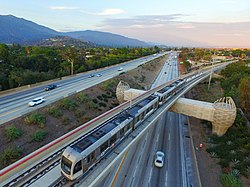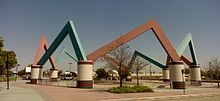Gold Line Foothill Extension
 Foothill Freeway overpass west of Sierra Madre Villa station | |||||||||||||||||||||||||||||||||||||||||||||||||||||||||||||||||||||||||||||||||||||||||||||||||||||||||||||||||||||||||||||||||||||||||||||||||||||||||||||||||||||||||||||||||||||||||||||||||||||
| Overview | |||||||||||||||||||||||||||||||||||||||||||||||||||||||||||||||||||||||||||||||||||||||||||||||||||||||||||||||||||||||||||||||||||||||||||||||||||||||||||||||||||||||||||||||||||||||||||||||||||||
| Status | Partially complete, construction ongoing | ||||||||||||||||||||||||||||||||||||||||||||||||||||||||||||||||||||||||||||||||||||||||||||||||||||||||||||||||||||||||||||||||||||||||||||||||||||||||||||||||||||||||||||||||||||||||||||||||||||
| Locale | Los Angeles, Pasadena, Azusa, Montclair | ||||||||||||||||||||||||||||||||||||||||||||||||||||||||||||||||||||||||||||||||||||||||||||||||||||||||||||||||||||||||||||||||||||||||||||||||||||||||||||||||||||||||||||||||||||||||||||||||||||
| Termini | Sierra Madre Villa APU/Citrus College (Phase 2A) Montclair (Phase 2B) | ||||||||||||||||||||||||||||||||||||||||||||||||||||||||||||||||||||||||||||||||||||||||||||||||||||||||||||||||||||||||||||||||||||||||||||||||||||||||||||||||||||||||||||||||||||||||||||||||||||
| Service | |||||||||||||||||||||||||||||||||||||||||||||||||||||||||||||||||||||||||||||||||||||||||||||||||||||||||||||||||||||||||||||||||||||||||||||||||||||||||||||||||||||||||||||||||||||||||||||||||||||
| Type | Light rail | ||||||||||||||||||||||||||||||||||||||||||||||||||||||||||||||||||||||||||||||||||||||||||||||||||||||||||||||||||||||||||||||||||||||||||||||||||||||||||||||||||||||||||||||||||||||||||||||||||||
| System | Los Angeles Metro Rail | ||||||||||||||||||||||||||||||||||||||||||||||||||||||||||||||||||||||||||||||||||||||||||||||||||||||||||||||||||||||||||||||||||||||||||||||||||||||||||||||||||||||||||||||||||||||||||||||||||||
| Operator(s) | |||||||||||||||||||||||||||||||||||||||||||||||||||||||||||||||||||||||||||||||||||||||||||||||||||||||||||||||||||||||||||||||||||||||||||||||||||||||||||||||||||||||||||||||||||||||||||||||||||||
| History | |||||||||||||||||||||||||||||||||||||||||||||||||||||||||||||||||||||||||||||||||||||||||||||||||||||||||||||||||||||||||||||||||||||||||||||||||||||||||||||||||||||||||||||||||||||||||||||||||||||
| Opened | March 5, 2016 (Phase 2A) 2025 (Phase 2B to Pomona) 2028 (Phase 2B to Montclair) | ||||||||||||||||||||||||||||||||||||||||||||||||||||||||||||||||||||||||||||||||||||||||||||||||||||||||||||||||||||||||||||||||||||||||||||||||||||||||||||||||||||||||||||||||||||||||||||||||||||
| Technical | |||||||||||||||||||||||||||||||||||||||||||||||||||||||||||||||||||||||||||||||||||||||||||||||||||||||||||||||||||||||||||||||||||||||||||||||||||||||||||||||||||||||||||||||||||||||||||||||||||||
| Line length | 23.9 mi (38.5 km) (overall) 11.3 mi (18.2 km) (Phase 2A only) | ||||||||||||||||||||||||||||||||||||||||||||||||||||||||||||||||||||||||||||||||||||||||||||||||||||||||||||||||||||||||||||||||||||||||||||||||||||||||||||||||||||||||||||||||||||||||||||||||||||
| Track gauge | 4 ft 8+1⁄2 in (1,435 mm) | ||||||||||||||||||||||||||||||||||||||||||||||||||||||||||||||||||||||||||||||||||||||||||||||||||||||||||||||||||||||||||||||||||||||||||||||||||||||||||||||||||||||||||||||||||||||||||||||||||||
| Electrification | 750 V DC overhead line | ||||||||||||||||||||||||||||||||||||||||||||||||||||||||||||||||||||||||||||||||||||||||||||||||||||||||||||||||||||||||||||||||||||||||||||||||||||||||||||||||||||||||||||||||||||||||||||||||||||
| |||||||||||||||||||||||||||||||||||||||||||||||||||||||||||||||||||||||||||||||||||||||||||||||||||||||||||||||||||||||||||||||||||||||||||||||||||||||||||||||||||||||||||||||||||||||||||||||||||||
The Gold Line Foothill Extension is an extension of the Metro Gold Line light rail corridor from its former terminus in Pasadena, California, east through the "Foothill Cities" of Los Angeles County into San Bernardino County. The first stage of the plan, Phase 2A, extended the Gold Line from Pasadena to Azusa; it opened on March 5, 2016. Phase 2B, which will extend the line a further six stations to the Montclair Transcenter, broke ground in December 2017.[1]
The corridor extension forms a part of the Los Angeles County Metro Rail system, and is being planned and implemented by the Gold Line Foothill Extension Construction Authority.[2][3] In addition to enhancing mobility in one of the most congested metropolitan areas in the United States, the 23.9-mile project (38.5 km) is seen as an economic catalyst for the region, generating 6,900 jobs during the construction phase and creating infill and transit-oriented development opportunities.[4]
By the time this project is fully completed, the Regional Connector will have already begun revenue service, at which time the north (Pasadena-Azusa-Montclair) branch of the Gold Line will be absorbed into the A Line, providing service from Long Beach via Downtown Los Angeles and Pasadena to Montclair.[5][6][7]
Route[]

The entire 23.9-mile (38.5 km) route (Phase 2A and 2B) of the Foothill Gold Line follows the roadbed of the former Atchison, Topeka & Santa Fe Railway's Second Division through the Foothill Cities. These cities are located in the foothills south of the San Gabriel Mountains, in the northern San Gabriel and Pomona Valleys. Beginning at the existing Metro Gold Line station in East Pasadena, the route extends roughly east from there, ending in Montclair. The route parallels several major roads and highways, including I-210 (Foothill Freeway), Huntington Drive, and Foothill Boulevard.[8]
Planning and Phase 2A[]
The Foothill Gold Line was originally conceived as Phase 2 of the Metro Gold Line. The route between Los Angeles and Pasadena is considered "Phase 1"; calling the Foothill Extension Phase 2 turned out to be a misnumbering, as the Gold Line Eastside Extension was completed in 2009, between the two phases. The Gold Line Construction Authority, which took over the Phase 1 project from Metro in 1999, is now coordinating the Phase 2 projects as well.
The initial Draft Environmental Impact Report (DEIR) for the Foothill Gold Line was completed in April 2006, and covered the entire corridor between Sierra Madre Villa station in Pasadena and Montclair. The Final Environmental Impact Report (FEIR) study assessed two different construction options: an LRT Full Build alternative which would complete the entire extension to Montclair, and an LRT Build To Azusa alternative, which would extend only to Azusa; this was dubbed Phase 2A. On February 28, 2007, the Construction Authority Board certified the Final EIR and decided to complete the "LRT Build to Azusa" alternative.[9]
In October 2009, the Metro board unanimously voted to include the Foothill Gold Line in its long-range plan, and approved funding for the construction and operation of Phase 2A. A groundbreaking ceremony for Phase 2A was held on June 26, 2010;[10] construction began the following summer and was completed in September 2015, with the extension entering service on March 5, 2016. The original project budget for Phase 2A was $690 million, including not only construction, but also purchase of vehicles, financing, administrative costs, mitigation, and other costs;[11] in March 2011, the Construction Authority requested an $45 million increase in total budget, to $735 million, to reflect updated cost estimates.[12]
Phase 2B to Montclair[]
Phase 2B is the project to extend the Gold Line from the Phase 2A terminus in Azusa east to Montclair. The Final EIR was certified by the Authority Board in March 2013.[13]
Proposed station listing[]

Phase 2B is 12.6 miles (20.3 km) long and will take approximately 17.9 minutes to traverse.[8] The alignment will have six new Metro stations: Glendora; San Dimas; La Verne; Pomona, at Pomona (North) Metrolink station with a connection to San Bernardino Line; Claremont, at Claremont Metrolink station with a connection to San Bernardino Line; and Montclair, at Montclair Transcenter with a connection to San Bernardino Line and Foothill Transit Silver Streak.
Foothill Gold Line expects 17,800 riders by 2035.[14]
Status[]
Planning for the Foothill Gold Line Phase 2B (Azusa to Montclair) began in 2003, and significant work has been completed for the segment. The Final EIR for the project was certified by the Construction Authority board in March 2013, and advanced conceptual engineering began in 2014. On June 23, 2017 LA Metro's board of directors approved a $1.4 billion budget Thursday to extend the Gold Line from APU/Citrus College station to Claremont, 11.5 miles to the east.[15] It is expected to cost an additional $70 million to extend the Gold Line from Claremont to Montclair, across county lines.[16]
Phase 2B of the Gold Line extension is composed of Project 1 and Project 2.[17] Project 1 is the relocation of Metrolink and freight railroad tracks, which is expected to begin in mid-2020 and conclude after several years.[17] Project 2 is the construction of the light rail line itself the Gold Line utilizes, which is expected to begin in late 2021.[17]
On December 2, 2017 officials broke ground for Phase 2B in a ceremony at Citrus College. The cost of the project is estimated at $1.5 billion.[1] Completion of Phase 2B (including Montclair Transcenter) is expected by early 2026.[17]
On July 10, 2020 major construction began on Phase 2B, building four stations from Azusa to Pomona with service estimated to start in 2025. Full construction to Claremont and Montclair by 2028 depends on additional funding that has to be secured by October 2021.[18]
As of January 2021, the extension is 20.4% completed.[19]
Proposed phase to Ontario Airport[]
California State Legislator Chris Holden representing California assembly district 41 proposed a measure in January 2020 that would extend the final phase from Montclair to Ontario Airport. The planned terminus in Montclair is six miles from the airport. Measure AB211 would form the San Bernardino County Rail Construction authority that would be in charge of the project.[20]
References[]
- ^ Jump up to: a b "Extension of Gold Line rail system to San Bernardino County breaks ground". Los Angeles Times. December 2017. Retrieved 2 December 2017.
- ^ "Foothill Gold Line (official project website)". Metro Gold Line Foothill Extension Construction Authority. Retrieved 2014-11-22.
- ^ "Gold Line Foothill Extension". Metro (LACMTA). Retrieved 2014-11-22.
- ^ "Economic Impact Study: Metro Gold Line Foothill Extension Phase 2A" (PDF). Los Angeles Economic Development Corporation. January 11, 2010. Archived from the original (PDF) on November 10, 2012. Retrieved 2014-11-22.
- ^ "Prepare for Our "Gold Line" to Be The "Blue Line" | ColoradoBoulevard.net". ColoradoBoulevard.net. 2017-09-25. Retrieved 2018-11-22.
- ^ "Regional Connector Transit Corridor". US Department of Transportation. 2015-01-20. Retrieved 2018-11-22.
- ^ "The Metro Blue Line will soon be called the 'A Line' • Long Beach Post". lbpost.com. Retrieved 2018-12-12.
- ^ Jump up to: a b "Gold Line Phase II Final Environment Impact Report: Chapter 2 - Alternatives" (PDF). Gold Line Foothill Construction Authority. February 2007. pp. 2–100. Retrieved 2014-11-22.
- ^ "Board resolution to certify FEIR" (PDF). Gold Line Foothill Construction Authority. 28 February 2007. Retrieved 2010-09-21.[permanent dead link]
- ^ "Metro Gold Line Breaks Ground". KABC-TV. June 26, 2010. Archived from the original on June 29, 2011. Retrieved 2010-09-21.
- ^ "Project Overview and Status, presentation to the Design-Build Institute of America" (PDF). March 10, 2010. Retrieved 2010-09-21.[permanent dead link]
- ^ http://www.metro.net/board/Items/2011/03_March/20110324RBMItem7.pdf
- ^ "Azusa to Montclair Final EIR". Gold Line Foothill Construction Authority. Retrieved 2014-09-02.
- ^ Neal Broverman (August 21, 2012). "Plans Released for Gold Line Train to San Bernardino County". Curbed Los Angeles. Vox Media Inc. Retrieved 2015-01-07.
- ^ "Metro Gold Line Extension to Claremont Montclair". Curbed L.A.
- ^ "Foothill Gold Line". www.foothillgoldline.org. Archived from the original on 2017-08-13. Retrieved 2017-08-13.
- ^ Jump up to: a b c d "Glendora to Montclair Work Plan" (PDF). Foothill Gold Line. Retrieved August 13, 2017.
- ^ "Major Construction Begins on Foothill Gold Line Extension Project". NBC Los Angeles. 10 July 2020. Retrieved 18 August 2020.
- ^ https://foothillgoldline.org/wp-content/uploads/2021/01/2021-01-13-Board-Item-7d.pdf
- ^ "Lawmaker pushes LA Metro Gold Line extension to Ontario Airport". 29 January 2020.
External links[]
- Gold Line Foothill Extension Construction Authority – the construction authority overseeing this project.
- Los Angeles County Metropolitan Transportation Authority (Metro) – the county's transportation planning agency.
- Los Angeles Metro Gold Line Foothill Extension: A Photo Essay
- L Line (Los Angeles Metro)
- Los Angeles Metro Rail projects
- Proposed railway lines in California
- Public transportation in the San Gabriel Valley
- Railway lines opened in 2016
- Under construction tram and light rail transit systems
- 2025 in rail transport
- 2028 in rail transport

